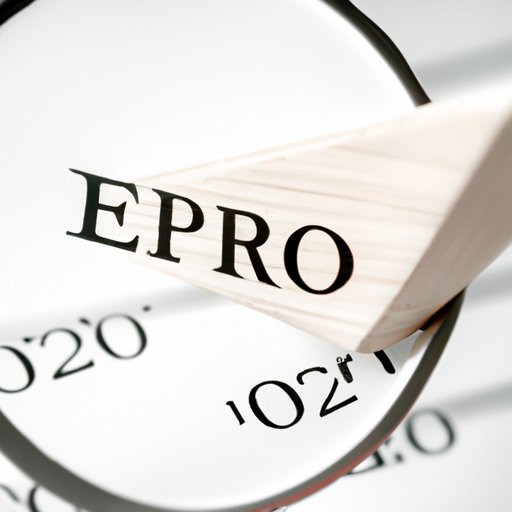
Introduction
If you’re working in a laboratory, you know that precise measurements are crucial for scientific research. But how can you determine whether your measurements are accurate? One of the ways is to calculate percent error for density. Percent error for density is a calculation that helps you assess the difference between the actual and experimental values of density. In this article, we’ll provide a comprehensive guide on how to calculate percent error for density to ensure that your measurements are as accurate as possible.
Step-by-Step Guide
Calculating percent error for density sounds complex, but it’s a straightforward process if you follow these simple steps:
Gather Data
The first step involves determining the actual and experimental values of density. Record the actual density value. You can find this value from reliable sources, such as product labels or databases. Next, collect experimental data by measuring the mass and volume of the substance you’re testing.
Calculate Actual and Experimental Density Values
Use the formula D=m/v to calculate the experimental density value. D stands for density, m stands for mass, and v stands for volume. For example, if the mass of the substance is 10 g and its volume is 5 ml, then:
D = m/v = 10 g/5 ml = 2 g/ml
You should also calculate the actual (or accepted) density value using the same formula.
Determine the Difference Between Actual and Experimental Values
Once you have both the actual and experimental values, you’ll need to find the difference between them. Subtract the experimental value from the actual value.
Divide the Difference by the Actual Value and Multiply by 100 to Get the Percent Error
To calculate the percent error for density, divide the difference you just calculated by the actual value. Multiply the result by 100 to get the percentage. For instance, if the actual density value is 1 g/ml and the experimental density value is 2 g/ml, then:
Percent error = (2 g/ml – 1 g/ml) / 1 g/ml x 100% = 100%
Practical Example
Let’s say you want to determine the density of a liquid. You measure its mass to be 15 g and its volume to be 10 ml. You look up the actual density value for this liquid, and it’s 1.3 g/ml. Using the steps outlined above, you can calculate the percent error for density as follows:
Experimental density value = m/v = 15 g/10 ml = 1.5 g/ml
The difference between the actual and experimental density values: 1.5 g/ml – 1.3 g/ml = 0.2 g/ml
Percent error = (0.2 g/ml / 1.3 g/ml) x 100% = 15.38%
Therefore, the percent error for density is 15.38%, which indicates that the density measurement is relatively accurate.
Comparing Two Values
What if you want to compare two different density values, such as experimental and accepted values? You can calculate their percent error using the same method as before. The formula for the percent error of comparing two different density values is:
Percent error = (experimental value – accepted value) / accepted value x 100%
For example, if the accepted density value for a particular substance is 1.4 g/ml, and the experimental density value is 1.6 g/ml, then:
Percent error = (1.6 g/ml – 1.4 g/ml) / 1.4 g/ml x 100% = 14.29%
You can use this method to compare different density values and determine whether they are within an acceptable range.
Importance of Accurate Measurements
Accurate measurements are crucial to scientific research because they allow scientists to draw the correct conclusions about a phenomenon or product. If measurements are faulty, incorrect conclusions may be reached, which can lead to severe consequences. Percent error for density helps evaluate measurement accuracy, enabling researchers to determine whether their data is reliable.
For example, in pharmaceutical research, incorrect density measurements could lead to improper dosages of medication, which could cause severe harm to patients. Similarly, inaccurate density measurements in environmental studies could lead to polluted water or air that negatively affects living organisms. By ensuring that measurements are accurate, percent error for density plays a critical role in preventing such scenarios.
Tips and Tricks
There are some tips and tricks that you can use to make the process of finding percent error for density more efficient. These include:
- Double-checking calculations to ensure accuracy
- Using online percent error calculators instead of manual calculations
- Averaging multiple readings to improve measurement accuracy
Common Mistakes to Avoid
When calculating percent error for density, some common mistakes can lead to incorrect results. Here are some of the most frequent mistakes and ways to avoid them:
- Misreading measurements, such as measuring mass in pounds instead of grams.
- Using the wrong actual value, which can occur when using outdated references or mixing up values for different materials.
- Not taking into account other variables that could influence measurements, such as temperature or pressure.
To avoid these mistakes, make sure you have a clear understanding of the units and formulas you’re using, use up-to-date references, and take into account the surrounding factors that could influence measurements.
Conclusion
Calculating percent error for density is a simple but important process for ensuring accurate measurements in scientific research. It helps to evaluate measurement accuracy and identify potential errors that could result in erroneous conclusions. By following the steps outlined in this article, you can calculate percent error for density confidently and avoid common mistakes.




